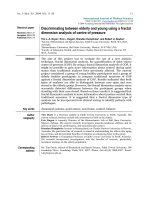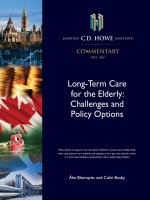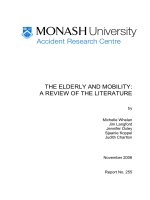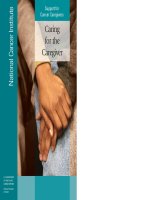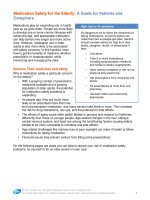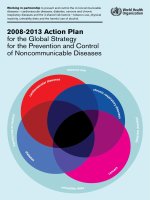Caring for the Elderly and Holding Down a Job: How Are Women Coping in Japan? potx
Bạn đang xem bản rút gọn của tài liệu. Xem và tải ngay bản đầy đủ của tài liệu tại đây (49.05 KB, 4 trang )
1
Asia–Pacific Population
&
Policy
POPULATION
POLICY
&
ASIAPACIFIC
POPULATION
POLICY
&
Caring for the Elderly and Holding
Down a Job: How Are Women
Coping in Japan?
POPULATION AND HEALTH STUDIES
April 2003
Number 65
Asia-Pacific Population
& Policy summarizes
research on population
and reproductive health
for policymakers and
others concerned with
the Asia-Pacific region.
This publication was made
possible through support
from the David and Lucile
Packard Foundation. The
opinions expressed do
not necessarily reflect the
views of the East-West
Center or of its supporters.
Writers:
Naohiro Ogawa
Robert D. Retherford
Yasuhiko Saito
Series Editor:
Sidney B. Westley
Editorial Committee:
Tim Brown
Minja Kim Choe
Philip Estermann
Robert D. Retherford
ISSN 0891-6683
Correspondence address:
East-West Center, Research Program
Population and Health Studies
1601 East-West Road
Honolulu, HI 96848-1601, USA
Telephone: (808) 944-7482
Fax: (808) 944-7490
E-mail:
Internet site: www.eastwestcenter.org
participants in the labor force and as
caregivers for the elderly. After decades
of low fertility, economic planners are
concerned about the country’s shrink-
ing work force. Japanese women who
stay on the job as they marry and raise
families play an important role in help-
ing to compensate for declining num-
bers of male workers.
Decades of low fertility combined
with rising life expectancies have also
resulted in rapid population aging—
growth of the oldest age groups as a
proportion of Japan’s total population.
As in other Asian countries, many eld-
erly people live with their adult chil-
dren, and primary responsibility for
their care tends to fall on middle-aged
daughters and daughters-in-law. As of
the mid-1990s, 23 percent of married
women in their forties and fifties lived
with their own or their husband’s par-
ents, according to the National Opin-
ion Survey on Female Labor, Rearing
of Infants, and Care of the Elderly.
Policymakers are worried that wom-
en who work may not be willing—or
able—to care for elderly family mem-
bers at home. The result could be few-
er women remaining in the work force,
greater government outlays on care for
the elderly, or both.
Can women do both—hold down a
job and look after the elderly? Draw-
ing on a recent national-level survey,
this issue of Asia-Pacific Population
&
Policy assesses how the age and health
status of elderly Japanese men and
women affect the labor-force participa-
tion of the middle-aged women in their
households.
ABOUT THE STUDY
The findings discussed here are from
the first round of Nihon University’s
Japan Longitudinal Study of Ageing.
The University’s Center for Informa-
tion Networking conducted field work
in late 1999 and early 2000.
The survey interviewed 4,997 men
and women age 65 and above. Of these,
1,044—or 21 percent—live with a mar-
ried daughter or daughter-in-law. This
analysis is restricted to these 1,044 eld-
erly respondents and the 1,044 adult
women who live with them.
Nearly all (97 percent) of the daugh-
ters and daughters-in-law are below
retirement age, which means that they
would have to retire early if they were
needed at home to care for an elderly
family member. The current work sta-
tus of these women is categorized as
full- or part-time employment outside
the home, family worker (for example,
in a family business or farm), or house-
wife.
Along with other characteristics, the
survey provides information on each
elderly person’s age and health. The re-
search team based their assessment of
M
iddle-aged women are the
focus of increasing policy
attention in Japan—both as
2
Asia–Pacific Population
&
Policy
Figure 1 Disability increases with age, but most of the elderly are healthy
Source: Data from Nihon University’s Japan Longitudinal Study of Ageing, 1999–2000.
Note: Health status is defined in terms of whether an elderly person can perform all 14 in-
ternationally accepted activities of daily living (ADLs) and instrumental activities of daily
living (IADLs) with no difficulty, has some or a lot of difficulty performing one or more ac-
tivities, or cannot perform one or more activities at all.
health status on an elderly person’s
ability to perform an internationally ac-
cepted set of activities of daily living
(ADLs) and instrumental activities of
daily living (IADLs). These range from
taking a bath or shower to using the
toilet, taking medicine as prescribed,
going shopping, preparing meals, and
paying bills. Health status is defined
in terms of performing each of the 14
tasks with no difficulty, some difficul-
ty, a lot of difficulty, or not at all.
Several other factors that might in-
fluence women’s work-force participa-
tion are considered in the analysis.
These include the elderly parent’s age,
sex, marital status (spouse present,
dead, or living elsewhere), education,
and income; whether the household is
in a rural or urban area; and whether
another daughter or daughter-in-law
(who could help with care) lives near-
by. Characteristics of the middle-aged
women include relationship to the eld-
erly parent (daughter or daughter-in-
law), age, education, number and age
of children and their level of school-
ing, and husband’s age and education.
These variables are included in the
analysis because their effects might
bias the estimated effects of an elderly
parent’s age and health status on a
woman’s work-force participation.
Such potentially confounding effects
are controlled using multinomial logis-
tic regression analysis.
ELDERLY MEN AND WOMEN:
MOSTLY HEALTHY, MOSTLY
YOUNG
Most of Japan’s elderly are in good
health, and most are in the youngest
post-retirement age group. Among the
1,044 elderly men and women includ-
ed in this analysis, nearly half (49 per-
cent) are age 65–74, and only 8 percent
are age 85 or older. Most (81 percent)
have no difficulty in performing any of
the 14 activities of daily living. Only 7
percent are unable to perform one or
more activities.
Reported disabilities increase steadi-
ly with age (Figure 1). Yet 42 percent of
men and women age 85 and older can
still perform all the daily activities
without difficulty. Only 25 percent are
unable to perform one or more activi-
ties at all.
Thus the large majority of the eld-
erly, even at age 85 and above, are in
fairly good health. Most middle-aged
women who live with these elderly
people should not have to quit their
jobs to care for them.
DAUGHTERS AND DAUGHTERS-
IN-LAW: MOSTLY WORKING
More than half (52 percent) of the wom-
en living with an elderly parent or par-
ent-in law work outside the home. This
is comparable with national statistics
on middle-aged women’s employment.
Among women in their 40s, more of
those who live with an elderly person
are working full-time and fewer are
working part-time than the national
average (Figure 2).
It is not surprising that full-time
employment is high among middle-
aged women who live with an elderly
family member. Most of the elderly
covered in this analysis are healthy, and
several studies have shown that elder-
ly household members provide consid-
erable help at home, including built-in
childcare. But what happens when an
elderly person who lives with a daugh-
ter or daughter-in-law grows older and
suffers from one or more disabilities?
AS THE ELDERLY GROW
OLDER
An elderly person’s age has a signifi-
cant effect on a married daughter or
daughter-in-law’s work status. As the
elderly person in a household grows
older, the middle-aged woman is less
likely to work full-time and more like-
ly to be a housewife (Figure 3). The like-
lihood of working part-time remains
about the same.
Fifty-nine percent of women who
live with a family member age 65–74
work full- or part-time outside the
home, compared with 40 percent of
women who live with a family mem-
0
20
40
60
80
100
65–74 75–84 85+
A
g
e
g
roup
Percent
Cannot perform
Lot of difficult
y
Some difficult
y
No difficult
y
3
Asia–Pacific Population
&
Policy
Figure 2 Married women age 4049 are more likely to work full-time outside the
home but less likely to work part-time if they live with an elderly relative
Source: Information on women living with an elderly person is from Nihon University’s
Japan Longitudinal Study of Ageing, 1999–2000. Information on all married women is from
a survey conducted by the Manichi Newspapers in 2000.
Note: Family worker refers to women who work in the traditional sector such as a family
farm or business where the place of work is usually in or near the home.
Figure 3 As the elderly grow older, the middle-aged women in their households are
more likely to be housewives and less likely to work full-time outside the home
Source: Naohiro Ogawa, Robert D. Retherford, and Yasuhiko Saito (2001). Care of the eld-
erly and women’s labor force participation in Japan. Paper presented at the Seminar on
Population Ageing in the Industrialized Countries: Challenges and Responses. Hosted by
the International Union for the Scientific Study of Population (IUSSP) and Nihon University’s
Population Research Institute, 19–21 March 2001, Tokyo, Japan.
Note: Net effects of parent’s age on woman’s work status with other characteristics of the
woman (including age) and of the parent (including health status) held constant, based on
multinoomial logistic regression.
ber age 85 or older. This pattern emerg-
es after controlling for the age of the
younger woman, the health status of
the elderly person, and all the other po-
tentially confounding variables.
The decision of a daughter or daugh-
ter-in-law to quit work as a parent
grows older may be based on a general
increase in frailty or an accumulation
of bouts of illness, both of which are
likely to be related to age. There may
also be a generational effect operating,
inasmuch as older parents tend to be
more traditional and may expect more
care at home from their daughters or
daughters-in-law.
The relationship between a woman’s
work-force participation and the age of
her elderly family member is particu-
larly important because the “oldest
old” are the fastest-growing age group
in Japan. In 2000, men and women age
85 and older accounted for 2 percent of
the national population—in 2050, they
are projected to account for 10 percent.
WHEN THE ELDERLY ARE
DISABLED
An elderly person’s disabilities also
have a significant influence on a daugh-
ter or daughter-in-law’s participation in
the work force, but mainly when these
disabilities are severe. When an elder-
ly person has some or a lot of difficulty
in performing any of the essential ac-
tivities of daily living, such problems
do not have a strong influence on the
daughter or daughter-in-law’s work-
force participation (Figure 4). When an
elderly person is unable to perform one
or more of the essential activities, how-
ever, the daughter or daughter-in-law
is much more likely to work full time
and much less likely to work part time
outside the home.
In the simplest form of the model,
the probability of a daughter or daugh-
ter-in-law working full time increases
from an average of 33 percent when the
elderly parent has “no, some, or a lot
of difficulty” performing any of the es-
sential activities to 42 percent when
the elderly parent is unable to perform
one or more activities. The probability
of the middle-aged woman working
part-time falls from an average of 19
percent for the first three categories of
24
14
30
28
22
18
22
38
0 5 10 15 20 25 30 35 40
Housewife
Famil
y
worker
Part-time outside
the home
Full-time outside the
home
Percent
All married women Married women livin
g
with an elderl
y
relative
0
10
20
30
40
50
65–74 75–84 85+
A
g
e of elderly parent
Percent
Full-time outside the home
Part-time outside the home
Family worker
Housewife
0
10
20
30
40
50
65–74 75–84 85+
A
g
e of elderly parent
Percent
Full-time outside the home
Part-time outside the home
Family worker
Housewife
4
Asia–Pacific Population
&
Policy
disability to 11 percent when the eld-
erly person is unable to perform one or
more activities.
This increase in full-time work may
occur because an elderly person with a
high level of disability is likely to be
hospitalized for long periods. Although
nursing-home care is rare in Japan, hos-
pital stays tend to be much longer than
in the West. One major expenditure
under the social security system is
long-term hospital care for the elderly.
When an elderly person is hospital-
ized, the daughter or daughter-in-law
is free to work full time. She may also
feel pressure to work to help defray the
cost of hospitalization, some of which
falls on the family.
One interesting result of the regres-
sion analysis is that an elderly person’s
age and health status affect a daughter
or daughter-in-law’s work-force partic-
ipation independently. Women who
live with an elderly parent or parent-
in-law are less likely to work either full
or part time outside the home as the
elderly person grows older but are more
likely to work full-time outside the
home if the elderly person becomes se-
riously disabled.
IMPLICATIONS FOR POLICY
Given the unprecedented level of pop-
ulation aging in Japan, the government
is rightly concerned about the financial
and personal costs of caring for the eld-
erly. One response has been a substan-
tial expansion of the social security
system in recent decades. Old-age pen-
sions and medical coverage became
universal in 1961, and benefits have
greatly increased since then.
But the policy of increasing benefits
has not been entirely consistent. In
1986, the government introduced poli-
cy measures to curb the escalating costs
of medical care for the elderly. New pol-
icies included the introduction of a co-
payment requirement for medical ser-
vices. In addition, the government has
promoted the establishment of geriat-
ric hospitals for long-term care. These
facilities are less costly to the govern-
ment than regular hospitals, but they
are more costly to elderly patients and
their families.
In light of the Japanese government’s
policy concerns, the primary implica-
tion of this analysis is that middle-aged
woman are unlikely to drop out of the
labor force in large numbers to care for
the elderly. Even in households with an
elderly person age 85 or older, fewer
than one-half of daughters or daughters-
in-law are full-time housewives.
Three trends suggest that labor-force
participation rates for these middle-
aged women may well increase. First,
Japan’s male labor force will continue
to shrink due to earlier declines in fer-
tility, so that women will continue to
be in demand to meet the country’s la-
bor requirements. In response, employ-
ers are beginning to provide flexible ar-
rangements that make employment
more attractive to married women with
responsibilities at home.
Second, Japan has recently estab-
lished the largest and most comprehen-
sive program of mandatory long-term
care insurance in the world. Announced
in April 2000, one goal of the new pro-
gram is to lighten the burden of pro-
viding in-home care for frail elderly per-
sons, for example by providing help
with housework and meal preparation.
If, given this type of assistance, more
of the elderly with disabilities remain
at home rather than staying in hospi-
tals for long periods, the result could
be less full-time and more part-time
employment for daughters and daugh-
ters-in-law. It does not seem likely,
however, that middle-aged women will
drop out of the work force altogether.
And finally, the tradition that mar-
ried women are required to care for
their elderly parents-in-law is weaken-
ing in Japan. One sign of this shift is a
dramatic change in residence patterns.
In 1975, more than half (54 percent) of
all households with a person age 65 or
older consisted of an elderly person or
couple living with their adult children.
In 2000, the proportion had dropped by
half—to 27 percent. As fewer Japanese
women live with their elderly parents
or parents-in-law, fewer will feel obli-
gated to quit work to care for them.
Figure 4 When the elderly are seriously disabled, the middle-aged women in their
households are more likely to work full time and less likely to work part time outside
the home
Source: See Figure 3.
Note: Net effects of parent’s health status on woman’s work with other characteristics of
the parent and the woman held constant, based on multinomial logistic regression.
0
10
20
30
40
50
No difficulty Some difficulty Lot of difficulty Cannot perform
Health status of elderly parent
Percent
Full-time outside the home
Part-time outside the home
Family worker
Housewife
0
10
20
30
40
50
No difficulty Some difficulty Lot of difficulty Cannot perform
Health status of elderly parent
Percent
Full-time outside the home
Part-time outside the home
Family worker
Housewife
